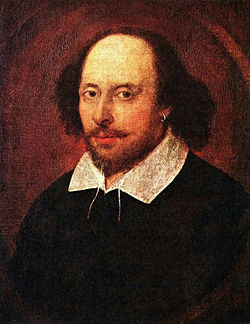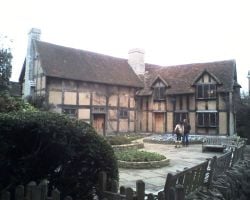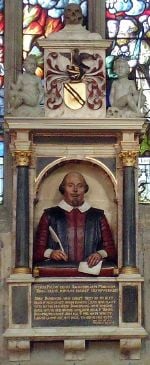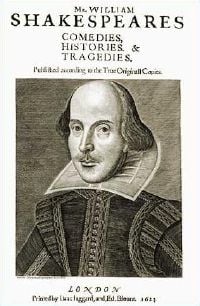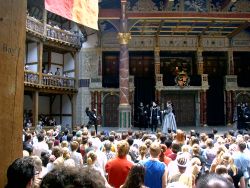William Shakespeare
William Shakespeare (Baptized April 26, 1564 ‚Äď April 23, 1616) was an English poet and playwright, widely regarded as the greatest writer in the English language and the world's preeminent dramatist. His surviving works consist of 38 plays, 154 sonnets, two long narrative poems, and several shorter poems. His plays have been translated into every major living language and are performed more often than those of any other playwright.
Shakespeare was born and lived in Stratford-upon-Avon. From 1585 until 1592 he began a successful career in London as an actor, writer, and part owner of the acting company the Lord Chamberlain's Men. He appears to have retired to Stratford around 1613, where he died three years later. Few records of Shakespeare's private life survive, and there has been considerable speculation about his life and prodigious literary achievements.
Shakespeare's early plays were mainly comedies and histories, genres he raised to the peak of sophistication by the end of the sixteenth century. In his following phase he wrote mainly tragedies, including Hamlet, King Lear, and Macbeth, Othello. The plays are often regarded as the summit of Shakespeare's art and among the greatest tragedies ever written. In 1623, two of his former theatrical colleagues published the First Folio, a collected edition of his dramatic works that included all but two of the plays now recognized as Shakespeare's.
Shakespeare's canon has achieved a unique standing in Western literature, amounting to a humanistic scripture. His insight in human character and motivation and his luminous, boundary-defying diction have influenced writers for centuries. Some of the more notable authors and poets so influenced are Samuel Taylor Coleridge, John Keats, Charles Dickens, Johann Wolfgang von Goethe, Herman Melville, and William Faulkner. According to Harold Bloom, Shakespeare "has been universally judged to be a more adequate representer of the universe of fact than anyone else, before or since."[1]
Shakespeare lived during the so-called Elizabethan Settlement in which relatively moderate English Protestantism gained ascendancy. Throughout his works he explored themes of conscience, mercy, guilt, temptation, forgiveness, and the afterlife. The poet's own religious leanings, however, are much debated. Shakespeare's universe is governed by a recognizably Christian moral order, yet threatened and often brought to grief by tragic flaws seemingly embedded in human nature much like the heroes of Greek tragedies.
He was a respected poet and playwright in his own day, but Shakespeare's reputation did not rise to its present heights until the nineteenth century. The Romantics, in particular, acclaimed his genius, and in the twentieth century, his work was repeatedly adopted and rediscovered by new movements in scholarship and performance. His plays remain highly popular today and are consistently performed and reinterpreted in diverse cultural and political contexts throughout the world.
Life
William Shakespeare was born in Stratford-upon-Avon, Warwickshire, England, in April 1564, the son of John Shakespeare, a successful tradesman and alderman, and of Mary Arden, a daughter of the gentry. Shakespeare's baptismal record dates to April 26 of that year.
Because baptisms were performed within a few days of birth, tradition has settled on April 23 as his birthday. This date is convenient as Shakespeare died on the same day in 1616.
As the son of a prominent town official, Shakespeare was entitled to attend King Edward VI Grammar school in central Stratford, which may have provided an intensive education in Latin grammar and literature. At the age of 18, he married Anne Hathaway on November 28, 1582 at Temple Grafton, near Stratford. Hathaway, who was 25, was seven years his senior. Two neighbors of Anne posted bond that there were no impediments to the marriage. There was some haste in arranging the ceremony, presumably as Anne was three months pregnant.
After his marriage, Shakespeare left few traces in the historical record until he appeared on the London theatrical scene. The late 1580s are known as Shakespeare's "Lost Years" because little evidence has survived to show exactly where he was or why he left Stratford for London. On May 26, 1583, Shakespeare's first child, Susannah, was baptized at Stratford. Twin children, a son, Hamnet, and a daughter, Judith, were baptized on February 2, 1585. Hamnet died in 1596, Susanna in 1649, and Judith in 1662.
London and theatrical career
It is not known exactly when Shakespeare began writing, but contemporary allusions and records of performances show that several of his plays were on the London stage by 1592. He was well enough known in London by then to be attacked in print by the playwright Robert Greene:
…there is an upstart Crow, beautified with our feathers, that with his Tiger's heart wrapped in a Player's hide, supposes he is as well able to bombast out a blank verse as the best of you: and being an absolute Johannes factotum, is in his own conceit the only Shake-scene in a country.[2]
Scholars differ on the exact meaning of these words, but most agree that Greene is accusing Shakespeare of reaching above his rank in trying to match university-educated writers, such as Christopher Marlowe, Thomas Nashe and Greene himself.[3] The italicized line parodying the phrase "Oh, tiger's heart wrapped in a woman's hide" from Shakespeare’s Henry VI, part 3, along with the pun "Shake-scene," identifies Shakespeare as Greene’s target.
|
"All the world's a stage, and all the men and women merely players: they have their exits and their entrances; and one man in his time plays many parts..." |
| As You Like It, Act II, Scene 7, 139‚Äď42. |
Greene’s attack is the first recorded mention of Shakespeare in the London theatre. Biographers suggest that his career may have begun any time from the mid-1580s to just before Greene’s remarks.[4][5] From 1594, Shakespeare's plays were performed only by the Lord Chamberlain's Men, a company owned by a group of players, including Shakespeare, that soon became the leading playing company in London.[6] After the death of Queen Elizabeth in 1603, the company was awarded a royal patent by the new king, James I, and changed its name to the King's Men. The change of fortunes of the acting profession in Tudor England is noteworthy. As late as 1545 traveling actors were defined by statute as rogues and subject to arrest; largely due to Shakespeare's writing and staging, "rogues" now enjoyed the patronage of the king, and members of the King's Men were officially attached to the Court as Grooms of the Chamber.[7]
Shakespeare grew to maturity just as the theater was being reborn in London. London's first theater, the Red Lion, was built in 1567, and in 1576 James Burbage (father of the famed actor Richard Burbage for whom Shakespeare would write many parts), constructed the Theater, a conscious allusion to classical amphitheaters of antiquity.[7] In 1599, a partnership of company members built their own theatre on the south bank of the Thames, which they called the Globe. In 1608, the partnership also took over the Blackfriars indoor theatre. Records of Shakespeare's property purchases and investments indicate that the company made him a wealthy man. In 1597, he bought the second-largest house in Stratford, New Place, and in 1605, he invested in a share of the parish tithes in Stratford.
Some of Shakespeare's plays were published in quarto editions from 1594. By 1598, his name had become a selling point and began to appear on the title pages. Shakespeare continued to act in his own and other plays after his success as a playwright. The 1616 edition of Ben Jonson's Works names him on the cast lists for Every Man in His Humour (1598) and Sejanus, His Fall (1603). The absence of his name from the 1605 cast list for Jonson’s Volpone is taken by some scholars as a sign that his acting career was nearing its end.[8] The First Folio of 1623, however, lists Shakespeare as one of "the Principal Actors in all these Plays," some of which were first staged after Volpone, although we cannot know for certain what roles he played. In 1610, John Davies of Hereford wrote that "good Will" played "kingly" roles.[9] In 1709, Rowe passed down a tradition that Shakespeare played the ghost of Hamlet's father. Later traditions maintain that he also played Adam in As You Like It and the Chorus in Henry V, though scholars doubt the sources of the information.
Shakespeare divided his time between London and Stratford during his career. In 1596, the year before he bought New Place as his family home in Stratford, Shakespeare was living in the parish of St. Helen's, Bishopsgate, north of the River Thames. He moved across the river to Southwark by 1599, the year his company constructed the Globe Theater there. By 1604, he had moved north of the river again, to an area north of St Paul's Cathedral with many fine houses.
Later years
Shakespeare's last two plays were written in 1613, after which he appears to have retired to Stratford. He died on April 23, 1616, at the age of 52. He remained married to Anne until his death and was survived by his two daughters, Susannah and Judith. Susannah married Dr. John Hall, but there are no direct descendants of the poet and playwright alive today.
Shakespeare is buried in the chancel of Holy Trinity Church in Stratford-upon-Avon. He was granted the honor of burial in the chancel not on account of his fame as a playwright but for purchasing a share of the tithe of the church for £440 (a considerable sum of money at the time). A bust of him placed by his family on the wall nearest his grave shows him posed in the act of writing. Each year on his claimed birthday, a new quill pen is placed in the writing hand of the bust, and he is believed to have written the epitaph on his tombstone:
- Good friend, for Jesus' sake forbear,
- To dig the dust enclosed here.
- Blest be the man that spares these stones,
- But cursed be he that moves my bones.
Speculations
Over the years such figures as Walt Whitman, Mark Twain, Henry James, and Sigmund Freud have expressed disbelief that the commoner from Stratford-upon-Avon actually produced the works attributed to him.
The most prominent alternative candidate for authorship of the Shakespeare canon has been Edward de Vere, the 17th Earl of Oxford, an English nobleman and intimate of Queen Elizabeth. Other alternatives include Sir Walter Raleigh, Francis Bacon, Christopher Marlowe, and even Queen Elizabeth herself. Although alternative authorship is almost universally rejected in academic circles, popular interest in the subject has continued into the twenty-first century.
A related academic question is whether Shakespeare himself wrote every word of his commonly accepted plays, given that collaboration between dramatists routinely occurred in the Elizabethan theater. Serious academic work continues to attempt to ascertain the authorship of plays and poems of the time, both those attributed to Shakespeare and others.
Shakespeare's sexuality has also been questioned in recent years, as modern criticism has subordinated conventional literary and artistic concerns to often overtly political issues. Although 26 of Shakespeare's sonnets are love poems addressed to a married woman (the "Dark Lady"), 126 are addressed to a young man (known as the "Fair Lord"). The amorous tone of the latter group, which focuses on the young man's beauty, has been taken as evidence for Shakespeare's "bisexuality," although most critics from Shakespeare's time to the present day interpret them as referring intense friendship, not sexual love. Another explanation is that the poems are not autobiographical, so that the "speaker" of the sonnets should not be simplistically identified with Shakespeare himself. The etiquette of chivalry and brotherly love of the time enabled Elizabethans to write about friendship in more intense language than is common today.
Works
Plays
Scholars have often categorized Shakespeare's canon into four groupings: comedies, histories, tragedies, and romances; and his work is roughly broken into four periods. Until the mid-1590s, he wrote mainly comedies influenced by Roman and Italian models and history plays in the popular chronicle tradition. A second period began from about 1595 with the tragedy Romeo and Juliet and ended with the tragedy of Julius Caesar in 1599. During this time, he wrote what are considered his greatest comedies and histories. From about 1600 to about 1608, Shakespeare wrote most of his greatest tragedies, and from about 1608 to 1613, mainly tragicomedies or romances.
The first recorded works of Shakespeare are Richard III and the three parts of Henry VI, written in the early 1590s during a vogue for historical drama. Shakespeare's plays are difficult to date, however, and studies of the texts suggest that Titus Andronicus, The Comedy of Errors, The Taming of the Shrew and Two Gentlemen of Verona may also belong to Shakespeare’s earliest period. His first histories, which draw heavily on the 1587 edition of Raphael Holinshed's Chronicles of England, Scotland, and Ireland, dramatize the destructive results of weak or corrupt rule and have been interpreted as a justification for the origins of the Tudor dynasty.[10] Their composition was influenced by the works of other Elizabethan dramatists, especially Thomas Kyd and Christopher Marlowe, by the traditions of medieval drama, and by the plays of Seneca.[11] The Comedy of Errors was also based on classical models; but no source for the The Taming of the Shrew has been found, though it is related to a separate play of the same name and may have derived from a folk story.[12] Like Two Gentlemen of Verona, in which two friends appear to approve of rape, the Shrew's story of the taming of a woman's independent spirit by a man sometimes troubles modern critics and directors.
Shakespeare's early classical and Italianate comedies, containing tight double plots and precise comic sequences, give way in the mid-1590s to the romantic atmosphere of his greatest comedies. A Midsummer Night's Dream is a witty mixture of romance, fairy magic, and comic low-life scenes. Shakespeare's next comedy, the equally romantic The Merchant of Venice, contains a portrayal of the vengeful Jewish moneylender Shylock which reflected Elizabethan views but may appear racist to modern audiences. The wit and wordplay of Much Ado About Nothing, the charming rural setting of As You Like It, and the lively merrymaking of Twelfth Night complete Shakespeare's sequence of great comedies. After the lyrical Richard II, written almost entirely in verse, Shakespeare introduced prose comedy into the histories of the late 1590s, Henry IV, parts I and 2, and Henry V. His characters become more complex and tender as he switches deftly between comic and serious scenes, prose and poetry, and achieves the narrative variety of his mature work.
This period begins and ends with two tragedies: Romeo and Juliet, the famous romantic tragedy of sexually charged adolescence, love, and death; and Julius Caesar‚ÄĒbased on Sir Thomas North's 1579 translation of Plutarch's Parallel Lives‚ÄĒwhich introduced a new kind of drama.[13] According to Shakespearean scholar James Shapiro, in Julius Caesar "the various strands of politics, character, inwardness, contemporary events, even Shakespeare's own reflections on the act of writing, began to infuse each other".[14]
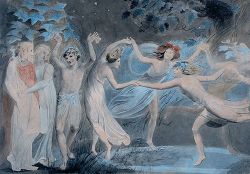
Shakespeare's so-called "tragic period" lasted from about 1600 to 1608, though he also wrote the so-called "problem plays" Measure for Measure, Troilus and Cressida, and All's Well That Ends Well during this time and had written tragedies before. Many critics believe that Shakespeare's greatest tragedies represent the peak of his art. The hero of the first, Hamlet, has probably been more discussed than any other Shakespearean character, especially for his famous soliloquy "To be or not to be; that is the question." Unlike the introverted Hamlet, whose fatal flaw is hesitation, the heroes of the tragedies that followed, Othello and King Lear, are undone by hasty errors of judgement. The plots of Shakespeare's tragedies often hinge on such fatal errors or flaws, which overturn order and destroy the hero and those he loves. In Othello, the villain Iago stokes Othello's sexual jealousy to the point where he murders the innocent wife who loves him. In King Lear, the old king commits the tragic error of giving up his powers, triggering scenes which lead to the murder of his daughter and the torture and blinding of the Duke of Gloucester. According to the critic Frank Kermode, "the play offers neither its good characters nor its audience any relief from its cruelty".[15] In Macbeth, the shortest and most compressed of Shakespeare's tragedies, uncontrollable ambition incites Macbeth and his wife, Lady Macbeth, to murder the rightful king and usurp the throne, until their own guilt destroys them in turn. In this play, Shakespeare adds a supernatural element to the tragic structure. His last major tragedies, Antony and Cleopatra and Coriolanus, contain some of Shakespeare's finest poetry and were considered his most successful tragedies by the poet and critic T. S. Eliot.[16]
In his final period, Shakespeare completed three more major plays: Cymbeline, The Winter's Tale and The Tempest, as well as the collaboration, Pericles, Prince of Tyre. Less bleak than the tragedies, these four plays are graver in tone than the comedies of the 1590s, but they end with reconciliation and the forgiveness of potentially tragic errors. Some commentators have seen this change in mood as evidence of a more serene view of life on Shakespeare's part, but it may merely reflect the theatrical fashion of the day. Shakespeare collaborated on two further surviving plays, Henry VIII and The Two Noble Kinsmen, probably with John Fletcher.[17]
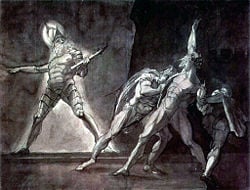
As was normal in the period, Shakespeare based many of his plays on the work of other playwrights and recycled older stories and historical material. For example, Hamlet (c. 1601) is probably a reworking of an older, lost play (the so-called Ur-Hamlet), and King Lear is an adaptation of an older play, King Leir. For plays on historical subjects, Shakespeare relied heavily on two principal texts. Most of the Roman and Greek plays are based on Plutarch's Parallel Lives (from the 1579 English translation by Sir Thomas North)[18], and the English history plays are indebted to Raphael Holinshed's 1587 Chronicles.
Some of Shakespeare's plays first appeared in print as a series of quartos, but most remained unpublished until 1623 when the posthumous First Folio was published. The traditional division of his plays into tragedies, comedies, and histories follows the logic of the First Folio. However, modern criticism has labeled some of these plays "problem plays" as they elude easy categorization and conventions, and has introduced the term "romances" for the later comedies.
There are many controversies about the exact chronology of Shakespeare's plays. In addition, the fact that Shakespeare did not produce an authoritative print version of his plays during his life accounts for part of Shakespeare's textual problem, often noted with his plays. This means that several of the plays have different textual versions. As a result, the problem of identifying what Shakespeare actually wrote became a major concern for most modern editions. Textual corruptions also stem from printers' errors, compositors' misreadings or wrongly scanned lines from the source material. Additionally, in an age before standardized spelling, Shakespeare often wrote a word several times in a different spelling, further adding to the transcribers' confusion. Modern scholars also believe Shakespeare revised his plays throughout the years, which could lead to two existing versions of one play.
Poetry
Shakespeare's sonnets are a collection of 154 poems that deal with such themes as love, beauty, politics, and mortality. All but two first appeared in the 1609 publication entitled Shakespeare's Sonnets; numbers 138 ("When my love swears that she is made of truth") and 144 ("Two loves have I, of comfort and despair") had previously been published in a 1599 miscellany entitled The Passionate Pilgrim.
The conditions under which the sonnets were published are unclear. The 1609 text is dedicated to one "Mr. W. H.," who is described as "the only begetter" of the poems by the publisher Thomas Thorpe. It is not known who this man was although there are many theories. In addition, it is not known whether the publication of the sonnets was authorized by Shakespeare. The poems were probably written over a period of several years.
In addition to his sonnets, Shakespeare also wrote several longer narrative poems, "Venus and Adonis," "The Rape of Lucrece" and "A Lover's Complaint." These poems appear to have been written either in an attempt to win the patronage of a rich benefactor (as was common at the time) or as the result of such patronage. For example, "The Rape of Lucrece" and "Venus and Adonis" were both dedicated to Shakespeare's patron, Henry Wriothesley, 3rd Earl of Southampton.
In addition, Shakespeare wrote the short poem ‚ÄúThe Phoenix and the Turtle.‚ÄĚ The anthology The Passionate Pilgrim was attributed to him upon its first publication in 1599, but in fact only five of its poems are by Shakespeare and the attribution was withdrawn in the second edition.
Shakespeare and religion
Shakespeare's writings have achieved a stature transcending literature. They have, says Harry Levin, "been virtually canonized as humanistic scriptures, the tested residue of pragmatic wisdom, a general collection of quotable texts and usable examples."[19] Although Shakespeare was immersed in a religiously saturated culture and themes of sin, prejudice, jealousy, conscience, mercy, guilt, temptation, forgiveness, and the afterlife appear throughout his writings, the playwright's religious sensibilities remains notoriously problematic. In part this may owe to the political perils of professing avowedly Catholic or other doctrinally suspect sympathies in the Protestant reigns of Elizabeth I and James I.
"What were Shakespeare's beliefs?" Aldous Huxley asked in his last published work (dictated on his deathbed). "The question is not an easy one to answer; for in the first place Shakespeare was a dramatist who made his characters express opinions which were appropriate to them, but which may not have been those of the poet. And anyhow did he himself have the same beliefs, without alteration or change or emphasis, throughout his life?"[20]
For Huxley, the poet's essential Christianity is apparent in Measure for Measure, when the saintly Isabella reminds the self-righteous Angelo of the divine scheme of redemption and of the ethical consequences which ought to follow from its acceptance in faith.[21]
- Alas, alas!
- Why, all the souls that were[,] were forfeit once;
- And He that might the vantage best have took
- Found out the remedy. How would you be,
- If He, which is the top of judgement, should
- But judge you as you are? O, think on that;
- And mercy then will breathe within your lips,
- Like man new-made. (Measure for Measure, Act 2, Scene 2)
Expressions of ethical Christianity are famously expressed in Portia's appeal to the vindictive Shylock in The Merchant of Venice:
- The quality of mercy is not strain'd,
- It droppeth as the gentle rain from heaven
- Upon the place beneath: it is twice blest;
- It blesseth him that gives and him that takes.(The Merchant Of Venice Act 4, scene 1)
The moral order, while divinely ordained, appears irreparably undone by human vices such as greed, jealousy, and a malignancy infecting the soul in such figures as Iago in Shakespeare's Othello. Traditional Christian categories of heaven, hell, and purgatory coexist in his writings with expressions of the fundamental disorientation of the human condition:
- Life's but a walking shadow; a poor player.
- That struts and frets his hour upon the stage,
- And then is heard no more: it is a tale
- Told by an idiot, full of sound and fury,
- Signifying nothing. (Macbeth, Act V, Scene 5)
For Shakespeare, at least as deduced from his writings, Christianity describes a moral order and code of conduct, more than a catalog of orthodox beliefs. The direct heir of humanists such as Petrarch, Boccaccio, Castiglione, and Montaigne, says critic Robert Grudin, Shakespeare "delighted more in presenting issues than in espousing systems, and held critical awareness, as opposed to doctrinal rectitude, to be the highest possible good."[22]
Possible Catholic sympathies
While little direct evidence exists, circumstantial evidence suggests that Shakespeare's family had Catholic sympathies and that he himself may have been Catholic, though this is much debated. In 1559, five years before Shakespeare's birth, the Elizabethan Religious Settlement finally severed the Church of England from the Roman Catholic Church. In the ensuing years, extreme pressure was placed on England's Catholics to convert to the Protestant Church of England, and recusancy laws made Catholicism illegal. Some historians maintain that in Shakespeare's lifetime there was a substantial and widespread quiet resistance to the newly imposed faith.[23][24] Some scholars, using both historical and literary evidence, have argued that Shakespeare was one of these recusants.[25]
There is some meager evidence that members of Shakespeare's family were recusant Catholics. One piece of evidence is a tract, of debated authenticity, professing secret Catholicism signed by John Shakespeare, father of the poet. The tract was found in the eighteenth century in the rafters of a house which had once been John Shakespeare's. John Shakespeare was also listed as one who did not attend church services, but this was "for feare of processe for Debtte," according to the commissioners, not because he was a recusant.[26]
Shakespeare's mother, Mary Arden, was a member of a conspicuous and determinedly Catholic family in Warwickshire. In 1606, William's daughter Susannah was listed as one of the residents of Stratford refusing to take Holy Communion in a Protestant service, which may suggest Catholic sympathies.[27] It may, however, also be a sign of Puritan sympathies, which some sources have ascribed to Susannah's sister Judith.[28] Archdeacon Richard Davies, an eighteenth century Anglican cleric, allegedly wrote of Shakespeare: "He dyed a Papyst".[29]
Four of the six schoolmasters at the grammar school during Shakespeare's youth, King’s New School in Stratford, were Catholic sympathizers,[30] and Simon Hunt, who was likely to have been one of Shakespeare’s teachers, later became a Jesuit.[31] A fellow grammar school pupil with Shakespeare, Robert Debdale, joined the Jesuits at Douai and was later executed in England for Catholic proselytizing.[30]
The writer's marriage to Anne Hathaway in 1582 may have been officiated, amongst other candidates, by John Frith [32] later identified by the crown as a Roman Catholic priest, although he maintained the appearance of a Protestant.[33] Some surmise Shakespeare wed in neighboring Temple Grafton rather than the Protestant Church in Stratford in order for his wedding to be performed as a Catholic sacrament.[33] Finally, one historian, Clare Asquith, has claimed that Catholic sympathies are detectable in his writing in the use of terms such as "high" when referring to Catholic characters and "low" when referring to Protestants, as well as other indicators in the text.[34]
Shakespeare’s Catholicism is by no means universally accepted. The 1914 edition of the Catholic Encyclopedia questioned not only his Catholicism, but whether "Shakespeare was not infected with the atheism, which…. was rampant in the more cultured society of the Elizabethan age."[35] Stephen Greenblatt suspects Catholic sympathies of some kind or another in Shakespeare and his family but considers the writer to be a less than pious person with essentially worldly motives.[36] An increasing number of scholars do look to biographical and other evidence from Shakespeare’s work, such as the placement of young Hamlet as a student at Wittenberg while old Hamlet’s ghost is in purgatory, the sympathetic view of religious life ("thrice blessed"), scholastic theology in The Phoenix and the Turtle, and sympathetic allusions to martyred English Jesuit St. Edmund Campion in Twelfth Night and many other matters as suggestive of a Catholic worldview.[37]
Shakepeare's influence
On theatre
Shakespeare's impact on modern theater cannot be overestimated. Not only did Shakespeare create some of the most admired plays in Western literature, he also transformed English theater by expanding expectations about what could be accomplished through characterization, plot, action, language and genre.[38] His poetic artistry helped raise the status of popular theater, permitting it to be admired by intellectuals as well as by those seeking pure entertainment.
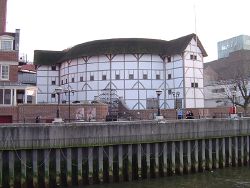
Theater was changing when Shakespeare first arrived in London in the late 1580s or early 1590s. Previously, the commonest forms of popular English theater were the Tudor morality plays. These plays, which blend piety with farce and slapstick, were allegories in which the characters are personified moral attributes that validate the virtues of Godly life by prompting the protagonist to choose such a life over evil. The characters and plot situations are symbolic rather than realistic. As a child, Shakespeare would likely have been exposed to this type of play (along with mystery plays and miracle plays). Meanwhile, at the universities, academic plays were being staged based on Roman closet dramas. These plays, often performed in Latin, placed a greater emphasis on poetic dialog but emphasized lengthy speechifying over physical stage action.
By the late 1500s the popularity of morality and academic plays waned as the English Renaissance took hold, and playwrights like Thomas Kyd and Christopher Marlowe began to revolutionize theater. Their plays blended the old morality drama with academic theater to produce a new secular form. The new drama had the poetic grandeur and philosophical depth of the academic play and the bawdy populism of the moralities. However, it was more ambiguous and complex in its meanings, and less concerned with simple moral allegories. Inspired by this new style, Shakespeare took these changes to a new level, creating plays that not only resonated on an emotional level with audiences but also explored and debated the basic elements of what it meant to be human.
In plays like Hamlet, says Roland Mushat, Shakespeare "integrated characterisation with plot" in a manner that plot becomes dependent upon the development of the principal characters.[39] In Romeo and Juliet, argues Jill Levenson, Shakespeare mixed tragedy and comedy to create a new romantic tragedy genre (previous to Shakespeare, romance had not been considered a worthy topic for tragedy).[40] Finally, through his soliloquies, Shakespeare explored a character's inner motivations and conflict, rather than, conventionally, to introduce characters, convey information, or advance the plot.[41]
Shakespeare's plays portrayed a wide variety of emotions, and his encyclopedic insight into human nature distinguished him from any of his contemporaries. Every day life in London, which was exploding with the growth of manufacturing, gave vitality to his language. Shakespeare even used "groundlings" (lower-class, standing-room spectators) widely in his plays, which, says Boris Ford, "saved the drama from academic stiffness and preserved its essential bias towards entertainment".[42] Shakespeare's earliest history plays and comedies portrayed the follies and achievements of kings, and "in shaping, compressing, and altering chronicles, Shakespeare gained the art of dramatic design; and in the same way he developed his remarkable insight into character, its continuity and its variation."[42]
On literature
Shakespeare is cited as an influence on a large number of writers in succeeding centuries, including Herman Melville, Charles Dickens, Thomas Hardy, and William Faulkner. Shakespearean quotations appear throughout Dickens' writings and many of Dickens' titles are drawn from Shakespeare. Melville frequently used Shakespearean devices, including formal stage directions and extended soliloquies, in Moby Dick.[43] In fact, Shakespeare so influenced Melville that the novel's main protagonist, Captain Ahab, is a classic Shakespearean tragic figure, "a great man brought down by his faults."[44] Shakespeare has also influenced a number of English poets, especially Romantic poets who were obsessed with self-consciousness, a modern theme Shakespeare anticipated in plays such as Hamlet. Shakespeare's writings were so influential to English poetry of the 1800s that critic George Steiner has called all English poetic dramas from Coleridge to Tennyson "feeble variations on Shakespearean themes."[45]
Shakespeare united the three main steams of literature: verse, poetry, and drama. To the versification of the language, he imparted his eloquence and variety giving highest expressions with elasticity of language. The second, the sonnets and poetry, was bound in structure. He imparted economy and intensity to the language. In the third and the most important area, the drama, he saved the language from vagueness and vastness and infused actuality and vividness. Shakespeare's work in prose, poetry, and drama marked the beginning of modernization of English literature by introduction of words and expressions, style and form to the language.
Shakespeare's use of blank verse is among the most important of his influences on the way the English language was written. He used the blank verse throughout in his career, experimenting and perfecting it. The free speech rhythm gave Shakespeare more freedom for experimentation. The striking choice of words in common place blank verse, says Boris Ford, influenced "the run of the verse itself, expanding into images which eventually seem to bear significant repetition, and to form, with the presentation of character and action correspondingly developed, a more subtle and suggestive unity".[42] Expressing emotions and situations in form of a verse gave a natural flow to language with an added sense of flexibility and spontaneity.
Scholars have also identified 20,000 pieces of music linked to Shakespeare's works. These include two operas by Giuseppe Verdi, Otello and Falstaff, whose critical standing compares with that of the source plays. Shakespeare has also inspired many painters, including the Romantics and the Pre-Raphaelites.[46][47] The psychoanalyst Sigmund Freud drew on Shakespearean psychology, in particular that of Hamlet, for his theories of human nature.[48]
On the English language
One of Shakespeare's greatest contributions is the introduction of vocabulary and phrases which enriched the English language, making it more colorful and expressive. Many original Shakespearean words and phrases have since become embedded in English, particularly through projects such as Samuel Johnson's Dictionary which quoted Shakespeare more than any other writer.[49]
Shakespeare lived during an era when the English language was loose, spontaneous, and relatively unregulated. In Elizabethan England one could "happy" your friend, "malice" or "foot" your enemy, or "fall" an ax on his head. And no one was a more exuberant innovator than Shakespeare, who could "uncle me no uncle" and "out-Herod Herod."[50] Lack of grammatical rules offered the genius of Shakespeare virtually unrestricted license to coin new terms, and the newly constructed London theaters became "the mint where new words were coined daily," according to Globe Theater director of education Patrick Spottiswoode.[7] The theater, agrees Boris Ford, was "a constant two way exchange between learned and the popular, together producing the unique combination of racy tang and the majestic stateliness that informs the language of Shakespeare".[42] It was a two way process in which literary language gained ascendancy in the process toward standardization and descriptive popular speech enriched the literary language.
Journalist Bernard Levin summed up the lasting impact of Shakespeare on the English language with his memorable compilation of Shakespearean coinages in The Story of English:[51]
If you cannot understand my argument, and declare "It's Greek to me," you are quoting Shakespeare; if you claim to be more sinned against than sinning, you are quoting Shakespeare; if you recall your salad days, you are quoting Shakespeare; if you act more in sorrow than in anger, if your wish is father to the thought, if your property has vanished into thin air, you are quoting Shakespeare; if you have ever refused to budge an inch or suffered from green-eyed jealousy, if you have played fast and loose, if you have been tongue-tied, a tower of strength, hoodwinked or in a pickle, if you have knitted your brows, made a virtue of necessity, insisted on fair play, slept not one wink, stood on ceremony, danced attendance (on your lord and master), laughed yourself into stitches, had short shrift, cold comfort or too much of a good thing, if you have seen better days or lived in a fool's paradise‚ÄĒwhy, be that as it may, the more fool you, for it is a foregone conclusion that you are (as good luck would have it) quoting Shakespeare; if you think it is early days and clear out bag and baggage, if you think it is high time and that is the long and short of it, if you believe that the game is up and that truth will out even if it involves your own flesh and blood, if you lie low till the crack of doom because you suspect foul play, if you have your teeth set on edge (at one fell swoop) without rhyme or reason, then‚ÄĒto give the devil his due‚ÄĒif the truth were known (for surly you have a tongue in your head) you are quoting Shakespeare; even if you bid me good riddance and send me packing, if you wish I was dead as a door-nail, if you think I am an eyesore, a laughing stock, the devil incarnate, a stony-hearted villain, bloody-minded or a blinkin idiot, then‚ÄĒby Jove! O Lord! Tut, tut! for goodness' sake! what the dickens! but me no buts‚ÄĒit is all one to me, for you are quoting Shakespeare.
Reputation
Shakespeare's reputation has grown considerably through the years. During his lifetime and shortly after his death, Shakespeare was well-regarded but not considered the supreme poet of his age. He was included in some contemporary lists of leading poets, but he lacked the stature of Edmund Spenser or Philip Sidney. After the Interregnum stage ban of 1642‚Äď1660, the new Restoration theater companies had the previous generation of playwrights as the mainstay of their repertory, most of all the phenomenally popular Beaumont and Fletcher team, but also Ben Jonson and Shakespeare. As with other older playwrights, Shakespeare's plays were mercilessly adapted by later dramatists for the Restoration stage with little of the reverence that would later develop.
Beginning in the late seventeenth century, Shakespeare began to be considered the supreme English-language playwright and, to a lesser extent, poet. Initially this reputation focused on Shakespeare as a dramatic poet, to be studied on the printed page rather than in the theater. By the early nineteenth century, though, Shakespeare began hitting peaks of fame and popularity. During this time, theatrical productions of Shakespeare provided spectacle and melodrama for the masses and were extremely popular. Romantic critics such as Samuel Taylor Coleridge then raised admiration for Shakespeare to adulation or 'bardolatry', in line with the Romantic reverence for the poet as prophet and genius. In the middle to late nineteenth century, Shakespeare also became an emblem of English pride and a "rallying-sign," as Thomas Carlyle wrote in 1841, for the whole British Empire.
Shakespeare's continued supremacy, wrote critic Harold Bloom in 1999, is an empirical certainty: the Stratford playwright "has been universally judged to be a more adequate representer of the universe of fact than anyone else, before him or since. This judgment has been dominant at least since the mid-eighteenth century; it has been staled by repetition, yet it remains merely true. … He extensively informs the language we speak, his principal characters have become our mythology, and he, rather than his involuntary follower Freud, is our psychologist."[52]
This reverence has of course provoked a negative reaction. In the twenty-first century most inhabitants of the English-speaking world encounter Shakespeare at school at a young age, and there is a common association of his work with boredom and incomprehension. At the same time, Shakespeare's plays remain more frequently staged than the works of any other playwright and are frequently adapted into film.
List of works
|
|
|
|
|
|
Notes
- ‚ÜĎ Harold Bloom, Shakespeare: The Invention of the Human (New York: Riverhead, 1998, ISBN 1573221201).
- ‚ÜĎ Stephen Greenblatt, Will in the World: How Shakespeare Became Shakespeare (London: Pimlico, 2005, ISBN 0712600981), 213.
- ‚ÜĎ Peter Ackroyd, Shakespeare: The Biography (Doubleday, 2005. ISBN 0385511396), 176.
- ‚ÜĎ Stanley Wells, Shakespeare & Co. (New York: Pantheon, 2006, ISBN 0375424946), 28.
- ‚ÜĎ S. Schoenbaum, Shakespeare's Lives (Oxford: Oxford University Press, 1991, ISBN 0198186185), 144‚Äď146.
- ‚ÜĎ Schoenbaum, 184.
- ‚ÜĎ 7.0 7.1 7.2 Eric Olsen, "The Elizabethan Achievement," The World & I, December 2003, 80.
- ‚ÜĎ Wells, Shakespeare & Co., 28.
- ‚ÜĎ Schoenbaum, 200‚Äď201.
- ‚ÜĎ Irving Ribner, The English History Play in the Age of Shakespeare (London; New York: Routledge, (2005 ISBN 0415353149) 154‚Äď155.
- ‚ÜĎ Patrick Gerard Cheney, The Cambridge Companion to Christopher Marlowe (Cambridge: Cambridge University Press, 2004, ISBN 0521527341), 100.
- ‚ÜĎ Schoenbaum, 166.
- ‚ÜĎ Ackroyd, 353, 358.
- ‚ÜĎ James Shapiro, A Year in the Life of William Shakespeare (London: Faber and Faber, 2005, ISBN 0571214800), 151.
- ‚ÜĎ Frank Kermode, The Age of Shakespeare (London: Weidenfeld & Nicholson, 2004, ISBN 029784881X), 141‚Äď142.
- ‚ÜĎ T. S. Eliot, Elizabethan Essays (London: Faber & Faber, 1934), 59.
- ‚ÜĎ Wells, Oxford, 1247, 1279.
- ‚ÜĎ Plutarch's Parallel Lives Plutarch's Parallel Lives. Retrieved December 22, 2006.
- ‚ÜĎ Harry Levin, "General Introduction," The Riverside Shakespeare (Boston: Houghton Mifflin, 1974, ISBN 0395044022), 1.
- ‚ÜĎ Aldous Huxley, "Shakespeare and Religion," sirbacon.org. Retrieved February 6, 2008. Reprinted in Huxley and God: Essays (Harper Collins, 1992).
- ‚ÜĎ Huxley, "Shakespeare and Religion"
- ‚ÜĎ Robert Grudin, "Humanism," Encyclopedia Britannica, Britannica 2003 Ultimate Reference Suite.
- ‚ÜĎ John Henry de Groot, The Shakespeares and ‚Äėthe Old Faith‚Äô. Doctoral dissertation, (1946)
- ‚ÜĎ Hildegard Hammerschmidt-Hummel. Die Verborgene Existenz Des William Shakespeare: Dichter Und Rebell Im Katholischen Untergrund. (2001); Shadowplay: The Hidden Beliefs and Coded Politics of William Shakespeare (2005) by Clare Asquith.
- ‚ÜĎ Richard Wilson,"Shakespeare and the Jesuits: New connections supporting the theory of the lost Catholic years in Lancashire," Times Literary Supplement, Dec. 19, 1997, 11-13. Retrieved August 15, 2013.
- ‚ÜĎ H. Mutschmannand K. Wentersdorf, Shakespeare and Catholicism (New York: Sheed and Ward, 1952), 401.
- ‚ÜĎ Ackroyd, 451
- ‚ÜĎ H. Thurston, Catholic Encyclopedia, 1913, The Religion of Shakespeare newadvent.org. with original scholarship from Richard Simpson in The Rambler (July, 1854, and March, April, and May, 1858). A volume rounded on the materials printed and manuscript accumulated by Simpson was afterwards published by Father H.S. Bowden, The Religion of Shakespeare. (London, 1899) Retrieved September 16, 2008.
- ‚ÜĎ The Religion of Shakespeare Catholic Encyclopedia on CD-ROM. Retrieved December 23, 2005.
- ‚ÜĎ 30.0 30.1 Ackroyd, 63‚Äď64.
- ‚ÜĎ H. Hammerschmidt-Hummel, "The most important subject that can possibly be": A Reply to E. A. J. Honigmann, Connotations, 2002-2003. Retrieved August 15, 2013.
- ‚ÜĎ Schoenbaum, 87.
- ‚ÜĎ 33.0 33.1 William marries Anne Hathaway "In Search of Shakespeare," P.B.S. (MayaVision International 2003) Retrieved September 16, 2008.
- ‚ÜĎ Clare Asquith, Shadowplay: The Hidden Beliefs and Coded Politics of William Shakespeare (PublicAffairs, 2005, ISBN 978-1586483166).
- ‚ÜĎ The Religion of Shakespeare Catholic Encyclopedia on CD-ROM. (Accessed Dec. 23, 2005.)
- ‚ÜĎ Greenblatt, 2004, 156-165.
- ‚ÜĎ Greenblatt, 2004, 338
- ‚ÜĎ E. K. Chambers. Shakespearean Gleanings. (Oxford: Oxford University Press, 1944 OCLC 2364570), 35
- ‚ÜĎ Roland Mushat Frye. Shakespeare. (Routledge, 2005), 118.
- ‚ÜĎ Jill L. Levenson, "Introduction" to Romeo and Juliet by William Shakespeare, (Oxford University Press, 2000), 49-50. In her discussion about the play's genre, Levenson quotes scholar H.B. Charlton Romeo and Juliet creating a new genre of "romantic tragedy."
- ‚ÜĎ Wolfgang H. Clemen. Shakespeare's Soliloquies. (Routledge, 1987), 179.
- ‚ÜĎ 42.0 42.1 42.2 42.3 Boris Ford, The Age of Shakespeare (London: Penguin Books, 1955).
- ‚ÜĎ John Bryant, "Moby Dick as Revolution" The Cambridge Companion to Herman Melville, Robert Steven Levine (editor) (Cambridge: Cambridge University Press, 1998), 82.
- ‚ÜĎ Carl F. Hovde, "Introduction" Moby-Dick by Herman Melville (Spark Publishing, 2003), xxvi.
- ‚ÜĎ Ronald L. Dotterer. Shakespeare: Text, Subtext, and Context. (Susquehanna University Press, 1989), 108
- ‚ÜĎ Roy Porter and Teich Mikul√°Ň°. Romanticism in National Context. (Cambridge: Cambridge University Press, 1988. ISBN 0521339138), 48
- ‚ÜĎ Lionel Lambourne. Victorian Painting. (London: Phaidon, 1999. ISBN 0714837768), 193‚Äď198(
- ‚ÜĎ Nicholas Royle, (2000). "To Be Announced" in The Limits of Death: Between Philosophy and Psychoanalysis. Joanne Morra, Mark Robson, Marquard Smith, (eds.) (Manchester: Manchester University Press, ISBN 0719057515).
- ‚ÜĎ Jack Lynch, Samuel Johnson's Dictionary: Selections from the 1755 Work that Defined the English Language (Delray Beach, FL: Levenger Press 2002), 12.
- ‚ÜĎ Robert McCrum, William Cran and Robert MacNeil, The Story of English (New York: Viking 1986 ISBN 0-670-80467-3) 99.
- ‚ÜĎ Bernard Levin, from McCrum, et.al, 96
- ‚ÜĎ Bloom, 16-17
ReferencesISBN links support NWE through referral fees
- Ackroyd, Peter. Shakespeare: The Biography. Doubleday, 2005. ISBN 0385511396
- Asquith, Clare. Shadowplay: The Hidden Beliefs and Coded Politics of William Shakespeare. PublicAffairs, 2005. ISBN 1586483870
- Bloom, Harold. Shakespeare: The Invention of the Human. New York: Riverhead, 1998. ISBN 1573221201
- Chambers, E.K. Shakespearean Gleanings. Oxford: Oxford University Press, 1944. ASIN B001PQ755G
- Cheney, Patrick Gerard. The Cambridge Companion to Christopher Marlowe. Cambridge: Cambridge University Press, 2004. ISBN 0521527341
- Clemen, Wolfgang H. Shakespeare's Soliloquies. Routledge, 1987.
- de Groot, John Henry. The Shakespeares and The Old Faith, with The Introduction by Stanley L. Jaki. (original 1946) Dissertation. reprint ed. Catholic Classics. ISBN 0964115034
- Dotterer, Ronald L. Shakespeare: Text, Subtext, and Context. Susquehanna University Press, 1989.
- Eliot, T.S. Elizabethan Essays. Haskell House, 1969. 978-0838305423
- Ford, Boris. The Age of Shakespeare. London: Penguin Books, 1982. ISBN 978-0140222654
- Greenblatt. Stephen. Will in the World: How Shakespeare Became Shakespeare. London: Pimlico, 2005. ISBN 0712600981
- Huxley, Aldous, "Shakespeare and Religion," reprinted in Huxley and God: Essays on Religious Experience. The Crossroad Publishing Company, 2003. ISBN 978-0824522520
- Kermode, Frank. The Age of Shakespeare. London: Weidenfeld & Nicholson, 2004. ISBN 029784881X
- Lambourne, Lionel. Victorian Painting. London: Phaidon, 1999. ISBN 0714837768
- Levin, Harry, "General Introduction," The Riverside Shakespeare. Boston: Houghton Mifflin, 1974. ISBN 0395044022
- McCrum, Robert, William Cran, and Robert MacNeil. The Story of English. New York: Viking, 1986. ISBN 0670804673
- Olsen, Eric. "The Elizabethan Achievement," The World & I (December 2003).
- Porter, Roy, and Teich Mikul√°Ň°. Romanticism in National Context. Cambridge: Cambridge University Press, 1988. ISBN 0521339138
- Ribner, Irving. The English History Play in the Age of Shakespeare. London; New York: Routledge, 2005. ISBN 0415353149
- Schoenbaum, S. Shakespeare's Lives. Oxford: Oxford University Press, 1991. ISBN 0198186185
- Shapiro, James. A Year in the Life of William Shakespeare. London: Faber and Faber, 2005. ISBN 0571214800
- Wells, Stanley. Shakespeare & Co. New York: Pantheon, 2006. ISBN 0375424946
External links
All links retrieved May 12, 2023.
- Open Source Shakespeare‚ÄĒcomplete works and a full concordance
- British Library; Original 93 copies in quarto
- The Complete Literary Works of William Shakespeare
- Works by William Shakespeare. Project Gutenberg
- Upenn.edu online books page for Shakespeare
- Full text of plays erroneously attributed to Shakespeare
- Essay on Shakespeare and Wallace Stevens
- The Illustrated Shakespeare
- Shakespeare Online
- Jennifer Vernon, Shakespeare's Coined Words Now Common Currency National Geographic News, 2004.
- Poetry Archive: 430 poems of William Shakespeare
Credits
New World Encyclopedia writers and editors rewrote and completed the Wikipedia article in accordance with New World Encyclopedia standards. This article abides by terms of the Creative Commons CC-by-sa 3.0 License (CC-by-sa), which may be used and disseminated with proper attribution. Credit is due under the terms of this license that can reference both the New World Encyclopedia contributors and the selfless volunteer contributors of the Wikimedia Foundation. To cite this article click here for a list of acceptable citing formats.The history of earlier contributions by wikipedians is accessible to researchers here:
- William_Shakespeare  history
- William_Shakespeare  history
- Shakespeare's_Influence  history
- Shakespeare's_Religion  history
The history of this article since it was imported to New World Encyclopedia:
Note: Some restrictions may apply to use of individual images which are separately licensed.
